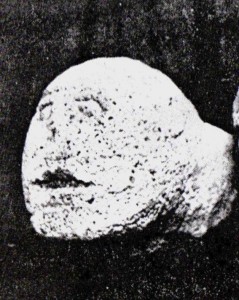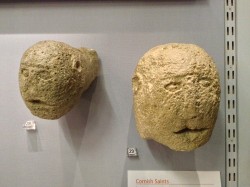Could this be Cornwall's earliest image of a woman?
/ Since we launched History 51 we have received a steady stream of interest in the project and ideas for which women we should be championing. One of the more intriguing to date has been a question raised by the St Piran Trust (Sen Piran Dasserghi) that one of three enigmatic carved heads found at St Piran's Oratory in Perranzabuloe could be one of the earliest representations of a woman in Cornwall.
Since we launched History 51 we have received a steady stream of interest in the project and ideas for which women we should be championing. One of the more intriguing to date has been a question raised by the St Piran Trust (Sen Piran Dasserghi) that one of three enigmatic carved heads found at St Piran's Oratory in Perranzabuloe could be one of the earliest representations of a woman in Cornwall.
We invited St Piran Trust to write this guest blog post and tell us a bit more about the oratory and the carved heads:
Cornwall's national saint
St Piran’s Oratory is an historically significant and culturally iconic site for Cornwall, located on Gear Sands 2km to the east of Perranporth. It is an early Christian chapel and cemetery, which tradition claims was built by St Piran (considered by many to be Cornwall’s national saint) sometime in the fifth or sixth century.
For centuries, the site served as a place for worship, commemoration of the dead and as a focus for pilgrimage, where the relics of St Piran would be venerated. It is thought that the remains of the Oratory were finally lost under windblown sand sometime in the early nineteenth century.
the oldest four-walled Christian edifice on mainland in Britain.
Early archaeological excavations
Later in the nineteenth century shifting sands uncovered the building and excavations in 1835 and 1843 completed the ‘rediscovery’ of what is thought to be the oldest four-walled Christian edifice on mainland in Britain.
A concrete block shell was constructed around the remains of the building in 1910 in an ultimately futile effort to protect it from flooding. In 1980, both the remains and the concrete shell were purposely reburied with sand in an effort to conserve them.
Whilst that action may have offered some short‐term conservation benefits, it is now believed that the sand is holding water which is deteriorating the remaining historic fabric of the Oratory. The structures are now included on the 'Heritage At Risk' register. At the 1980 reburial no interpretation was provided to explain the building and its significance to the history of Cornwall and Christianity in Britain.
The carved heads
The carved heads currently reside in the Royal Cornwall Museum (replicas are on display there). They were rediscovered when the Oratory was 'excavated' in 1835 by William Mitchell of Truro. He mentions the head of the tiger, but not the other heads: "The key stone of the arch projects 8 inches, on which is rudely sculptured a tyger's head."
...the head of a man and that of a woman rudely sculptured of stone most assuredly of very remote antiquity.
Later, in 1905, Thurstan C. Peter wrote that the Oratory was found "in a good state of preservation, ornamented with pretty tracery, the arch itself having on its key stone the head of a tiger, and [at] the points of the curve the head of a man and that of a woman rudely sculptured of stone most assuredly of very remote antiquity."
Oratory historian Eileen Carter, author of In the Shadow of Saint Piran firmly believes the heads to be from the Celtic/early medieval period (500 - 700 CE) and says they bear a remarkable similarity to carved heads at Clonmacnoise in Ireland (St Piran supposedly came from Ireland to Cornwall in the sixth century). There are more local comparisons, however, and the Oratory heads have also been compared to those at the Holy Well in St Anne's Church, Whitstone, north Cornwall.
However, more work needs to be done to properly assess the Oratory's age and the age of the figures. Why a man, a woman and a tiger (if indeed it is a tiger!)? Legend holds that St Piran's first converts were a badger, a fox and a bear - no tiger there [but every possibility that one of his first disciples was a woman, ed].
The future of the Oratory
Throughout the twentieth century the iconic status of the site has increased. It attracts thousands of visitors, and each year hundreds of Cornish people gather at the site to mark St Piran’s Day (5th March).
In 2010 Cornwall Council's Historic Environment Service undertook a thorough evaluation of the Oratory. It comprised a survey of the Oratory mound and its surrounding landscape to test the archaeological potential of the site and gain a better understanding of the condition of the concrete block structure and the monument.
The St Piran Trust, a voluntary charity, is working tirelessly to uncover the Oratory and conserve and interpret it for Cornwall and her visitors. The Trust is in the middle of making a Heritage Lottery Fund application to enable essential archaeological and conservation work to take place.
Acknowledgements: We are very grateful to St Piran Trust for contributing this blog post to History 51, and we wish them all the success with their Heritage Lottery Fund application and the development project, and look forward to understanding more about the origins of these fascinating Cornish faces.



